Dwarf hairgrass (Eleocharis parvula) is a fantastic choice for aquarists looking to create a lush, green lawn in their tanks. This adaptable plant, found in various coastal habitats worldwide, is known for its ease of care, making it ideal for both beginners and experienced hobbyists.
When properly maintained, dwarf hairgrass spreads quickly, forming a thick, vibrant carpet that enhances the beauty of any aquarium. It works particularly well in the foreground, mimicking the appearance of a natural grassland. For example, pairing it with colorful fish or contrasting plants can create a stunning focal point in your aquascape.
However, it’s essential to avoid common mistakes, such as providing inadequate lighting or using the wrong substrate, which can hinder its growth. To ensure your dwarf hairgrass thrives, aim for moderate to high light and a nutrient-rich substrate.
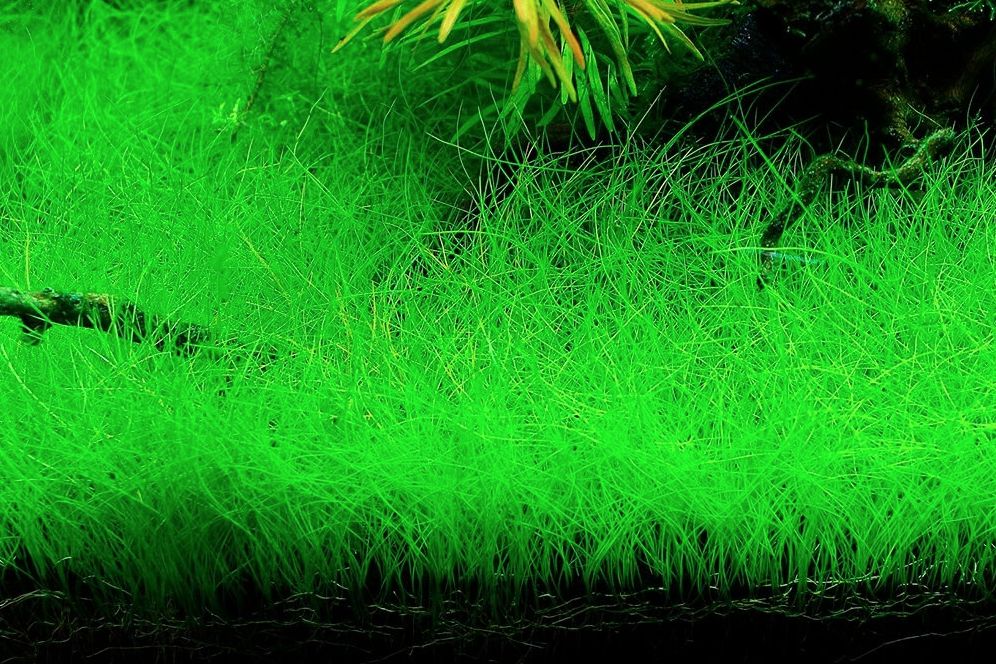
Contents
Plant Habitat in the wild
Eleocharis parvula belongs to the family Cyperaceae. Eleocharis parvula is a versatile plant found in a wide range of habitats across the circumboreal region. It thrives in Eurasia, stretches from North America to Central America, and can also be found in North Africa (Egypt) and parts of South America, including Cuba, Guatemala, Nicaragua, and Venezuela. Its adaptability to various conditions makes it a favorite among aquarists.
Typically, dwarf hairgrass grows in shallow freshwater environments, such as:
- Marshes
- Wetlands
- Edges of lakes and ponds
- Slow-moving streams
This plant often prefers sandy or gravelly substrates, where it forms dense carpets or clusters. However, it can also thrive in clay or muddy substrates, provided that sufficient light reaches it.
In its natural habitat, dwarf hairgrass encounters a variety of water conditions. It tolerates both soft and moderately hard water and adapts well to a range of pH levels, from slightly acidic to slightly alkaline.
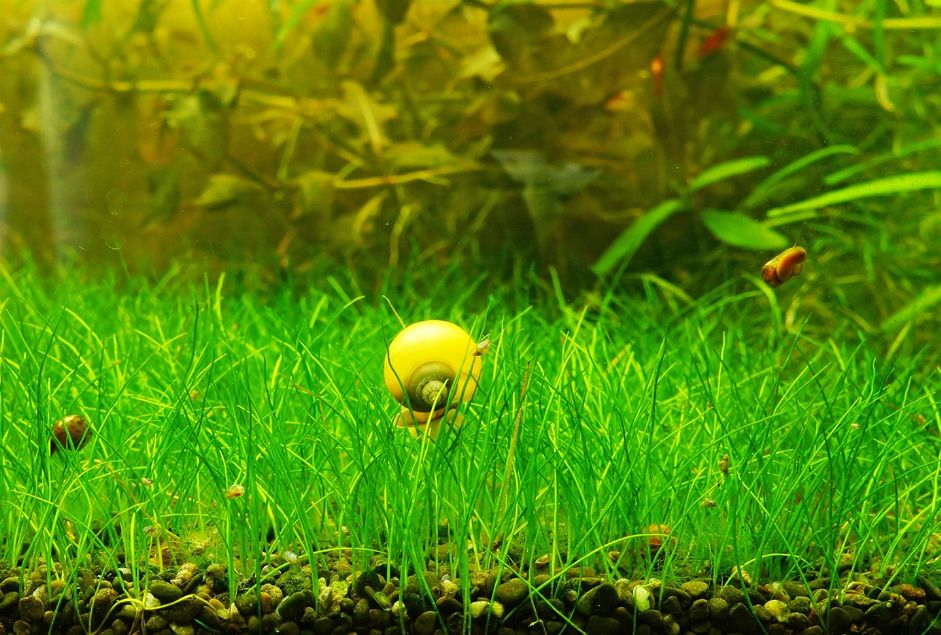
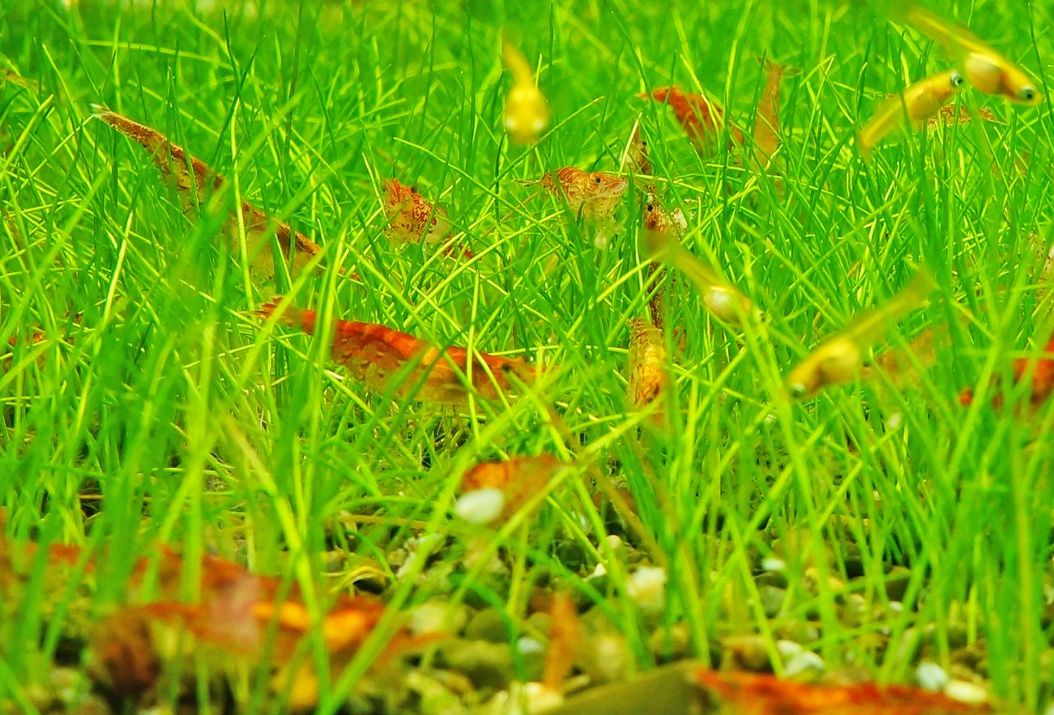
Description
With optimal conditions, this plant typically reaches a height of no more than 5 cm (2 inches). However, in low light conditions, it can grow up to 10 cm (4 inches) or more. Its thin, straight leaves resemble needles, adding a delicate touch to any aquascape.
The height of dwarf hairgrass is significantly influenced by the level of illumination it receives: the more light it gets, the shorter and denser the plant becomes. This species is known for its rapid growth; it propagates through branch shoots and can quickly cover a designated area in your aquarium.
Under ideal conditions, dwarf hairgrass spreads efficiently, creating a dense and vibrant carpet effect across the substrate. For aquarists, understanding these growth characteristics is crucial for maintaining a healthy tank. Common mistakes to avoid include providing insufficient lighting or using inappropriate substrates, both of which can stunt the plant’s growth.
Comparing Dwarf Hairgrass and Dwarf Hairgrass Mini
You should keep in mind, that dwarf hairgrass has several variations. The current article is about Eleocharis parvula. However, recently another species Eleocharis sp. mini has appeared, which is quite a seldom one for now, but it is quickly gaining popularity.
Requirements for keeping these species are identical, the difference is that Eleocharis sp. mini is smaller than Eleocharis parvula and it has twirled leaves, while Eleocharis parvula has straight leaves. Another thing is, that Eleocharis sp. mini grows very slowly.
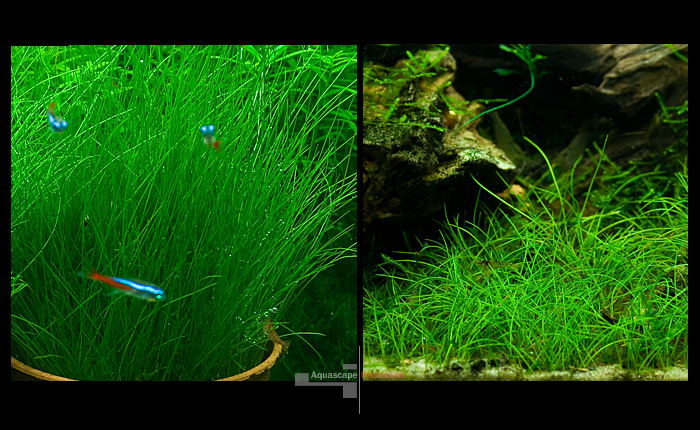
Here’s a comparison list highlighting the key differences between Eleocharis parvula (Dwarf Hairgrass) and Eleocharis sp. mini (Mini Hairgrass):
1. Size and Growth:
- Dwarf Hairgrass (Eleocharis parvula): Typically grows up to 5 cm (2 inches) under optimal conditions but can reach about 10 cm (4 inches) in lower light. It has a slightly taller and denser appearance.
- Dwarf Hairgrass Mini: Generally stays even smaller, often maxing out at around 3 cm (1 inch). Its shorter stature makes it ideal for smaller aquariums or for creating a more compact grassy effect.
2. Leaf Structure:
- Dwarf Hairgrass: Has slightly wider and longer leaves compared to the mini version, giving it a lush, carpet-like appearance.
- Dwarf Hairgrass Mini: Features finer, shorter leaves that create a more delicate look, often resembling a finer lawn or grass plot.
3. Growth Rate:
- Dwarf Hairgrass: Known for a relatively fast growth rate, it propagates through branch shoots, covering the substrate quickly.
- Dwarf Hairgrass Mini: While it also grows rapidly, its growth can be more controlled, making it easier to maintain a specific height and density in a smaller setup.
4. Light Requirements:
- Both varieties prefer similar light conditions, thriving in moderate to high lighting. However, the mini version may adapt slightly better to lower light settings without becoming too leggy.
5. Use in Aquascaping:
- Dwarf Hairgrass: Suitable for larger tanks or as a foreground plant in a more extensive aquascape.
- Dwarf Hairgrass Mini: Excellent for nano tanks or smaller aquascapes where space is limited, or for creating intricate patterns and designs.
6. Care and Maintenance:
- Both require similar care in terms of water parameters and substrate. However, due to its smaller size, dwarf hairgrass mini may require more frequent trimming to maintain its desired height and prevent overgrowth.
Conclusion
Choosing between dwarf hairgrass and dwarf hairgrass mini depends on the specific needs of your aquarium and the aesthetic you want to achieve. Both varieties offer beautiful greenery and can enhance your aquatic environment, so consider your tank size, design, and maintenance preferences when making your selection.
| Aspect | Dwarf Hairgrass (Eleocharis parvula) |
|---|---|
| Appearance | Thin, grass-like leaves forming dense carpets |
| Growth Rate | Fast-growing, spreads quickly and fills in well |
| Height | Typically 2-4 inches (5-10 cm) in height |
| Light Requirements | Moderate to high lighting preferred |
| CO2 Requirements | Can thrive without CO2 supplementation, but benefits from it |
| Nutrient Demands | Requires nutrient-rich substrate and regular fertilization |
| Propagation | Propagates through runners, forming new plantlets |
| Water Parameters | pH: 6.0-7.5, Temperature: 68°F-82°F (20°C-28°C) |
| Tolerates Hardness | Can tolerate a wide range of water hardness levels |
| Habitat | Native to temperate and subtropical regions worldwide |
| Versatility | Suitable for foreground carpeting in various aquascapes |
| Maintenance | Regular trimming to maintain desired height and density |
| Aesthetics | Provides a natural and vibrant look to aquariums |
| Adaptability | Resilient and adaptable to different water conditions |
Difficulties in keeping
This plant is not for beginners , though it is not a challenging one for experienced aquarists to keep. It takes a long time for dwarf hairgrass to strike roots after it was planted. That’s why, if it is possible, you shouldn’t use this plant at the stage of setting up an aquarium. If you are a beginner, choose simpler plants, such as vallisneria.
Provided with favorable conditions dwarf hairgrass grows rather quickly and easily forms a thick green lawn, which stands trimming quite well. Trimming the plant from time to time promotes appearance of new shoots and helps making the lawn thicker.
To ensure dwarf hairgrass stable growth rate it is recommended to supply CO2 and add fertilizers into the tank. In general, this is rather undemanding and very beautiful aquarium plant in case of a settled tank.
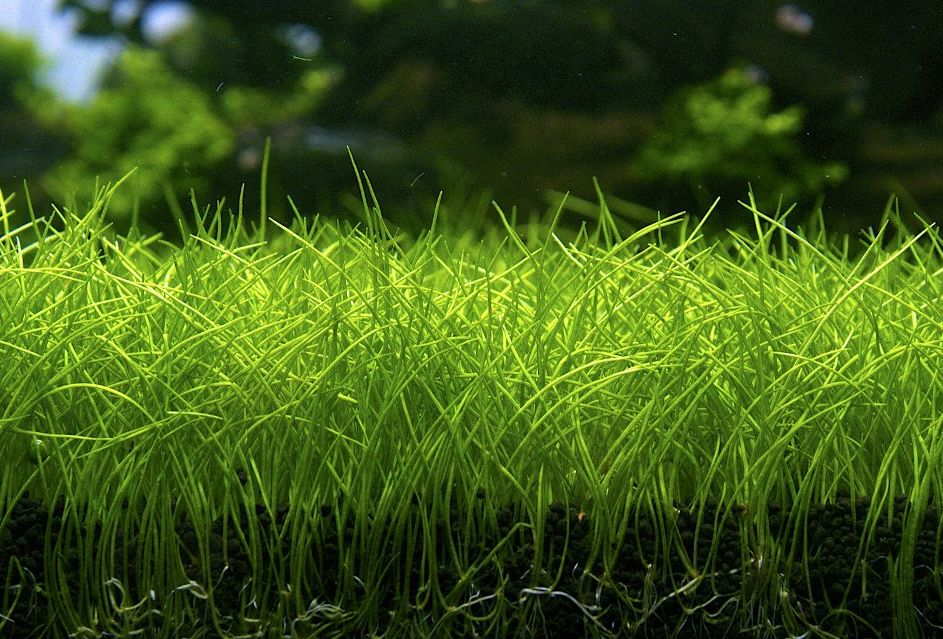
Carpet
Creating a lush and vibrant carpet of dwarf hairgrass (eleocharis parvula) in your aquarium is both aesthetically pleasing and rewarding. To achieve this stunning effect, follow these steps:
- Prepare the Substrate: Start with a fine-grained substrate, ensuring a depth of 2-3 inches (5-8 cm). It’s essential to use a nutrient-rich substrate or supplement it with root fertilizers to promote healthy growth.
- Planting: Trim the dwarf hairgrass into smaller portions, then evenly space and plant them in the substrate. This will help cover the desired area more effectively.
- Regular Maintenance: To maintain the carpet’s desired height and density, regularly trim the hairgrass. This encourages bushier growth and prevents any sections from becoming too tall.
- Monitor Conditions: Keep an eye on CO2 and nutrient levels, adjusting them as needed. Proper CO2 supplementation can significantly enhance growth and overall health.
Care and keeping in a tank
To grow healthily, dwarf hairgrass requires a few essential conditions: a nutritious substrate, intense lighting, a CO2 supply (ideally 10-15 mg/l), and proper water circulation in the tank. When these requirements are met, dwarf hairgrass thrives, creating a thick, lush carpet that can even penetrate shadowed areas of the substrate.
Shallow tanks with a large bottom surface area are ideal for cultivating dwarf hairgrass. In taller tanks, the plant’s growth rate may slow significantly or even halt entirely.
Initially, dwarf hairgrass may grow slowly as it adapts to its new environment. For the first three weeks, the plant focuses on establishing its roots and producing new shoots. During this adaptation phase, patience is key.
Lighting
Dwarf hairgrass thrives under moderate to high lighting conditions, which are crucial for its optimal growth and appearance. To achieve a lush carpet, provide lighting with sufficient intensity to penetrate the water and reach the lower portions of the aquarium. High-intensity lighting promotes compact growth, helping to prevent the plant from stretching.
To minimize the risk of algae fouling, it’s important to choose the right lamps with appropriate radiation patterns and to carefully manage the daylight duration. Aim for a lighting cycle that doesn’t exceed 10 hours per day, mimicking the natural day-night cycle. This allows the plant to undergo photosynthesis while providing necessary rest periods. Excessive lighting duration can lead to algae growth and stress the plants, undermining the beautiful carpet you’re working to establish.
By following these lighting guidelines and avoiding common mistakes, such as using inadequate light intensity or excessive duration, you can help your dwarf hairgrass flourish.
Water parameters
Dwarf hairgrass thrives in a temperature range of approximately 68°F to 82°F (20°C to 28°C), covering the typical tropical and subtropical temperatures found in many aquariums. For optimal growth, aim for a water temperature around 23°C. While the plant can tolerate slight fluctuations, it can withstand temperatures as low as 20°C.
Water pH should be maintained between 6 and 7, and water hardness should not exceed 8 KH. Keeping these parameters stable is crucial for the health of your dwarf hairgrass.
Additionally, the thin stems of dwarf hairgrass are sensitive to algae fouling and other biological contaminants. To ensure successful growth, maintain a clean tank environment by using a high-quality filter and performing regular partial water changes.
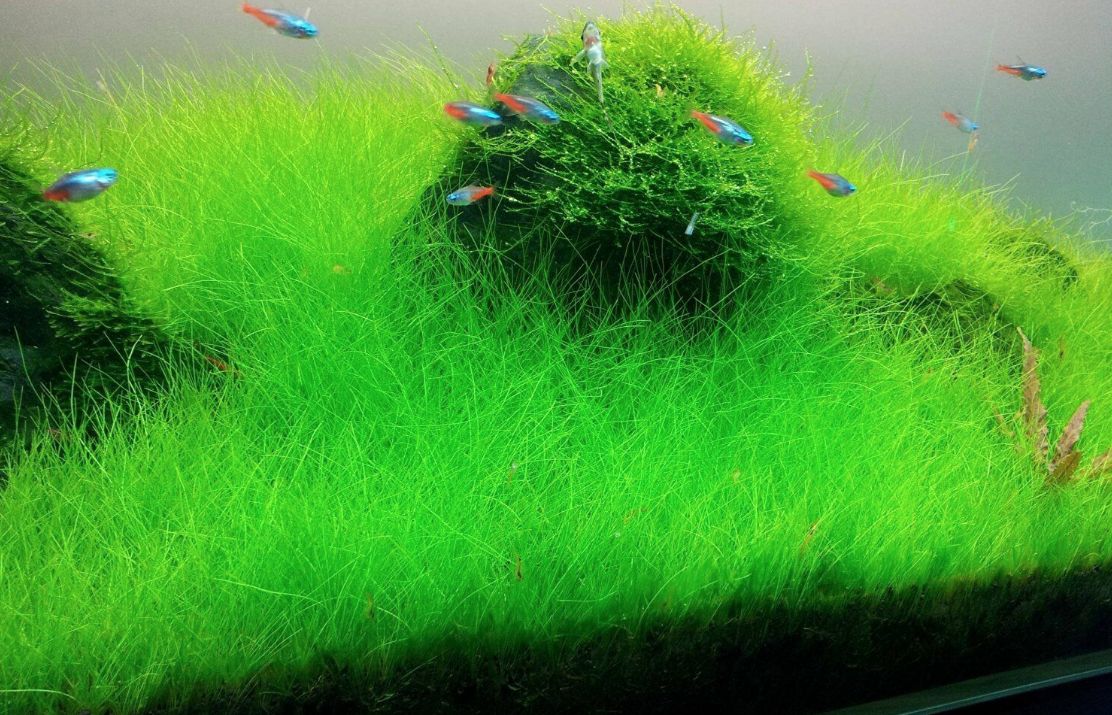
Substrate
Dwarf hairgrass thrives best in a fine-grained substrate, such as aquarium sand, fine gravel, or specialized planted tank substrates. The small particle size allows the plant’s roots to anchor easily and spread throughout the substrate. Consider using substrates specifically designed for planted aquariums, as they often contain essential nutrients like iron, potassium, and other trace elements that promote healthy growth.
The substrate layer should be at least 4 cm thick, with grain sizes no larger than 3 mm. Larger grains can hinder the plant’s ability to root properly, making it difficult for dwarf hairgrass to establish itself.
Additionally, it’s important to periodically siphon the tank bottom under the plant clusters, as this area can accumulate silt over time.
Trimming dwarf hairgrass
To maintain a healthy and attractive dwarf hairgrass lawn, regular maintenance is essential. As the plant ages, older leaves will gradually rot away. To keep the carpet looking its best, gently move the plant to encourage these decaying leaves to float to the water surface. Be cautious during this process to avoid uprooting the plant from the substrate.
Regular trimming is also important. Aim to keep the grass trimmed to about 2.5 cm (1 inch) in height. This practice not only promotes the growth of new shoots but also helps create a thicker, more vibrant carpet.
In areas behind stones or in shadowed spots, it’s best to refrain from trimming. Allowing these sections to grow naturally contributes to a heterogeneous, natural look for your lawn.
CO2
Eleocharis parvula can grow and survive without supplemental CO2 injection in the aquarium, making it a relatively low-maintenance plant regarding carbon dioxide (CO2) requirements. However, providing CO2 supplementation can significantly enhance the growth and overall health of dwarf hairgrass, especially in setups with high lighting and nutrient-rich conditions.
For aquarists using strong lighting and a well-fertilized substrate, adding CO2 can lead to faster growth, denser foliage, and improved overall vitality. In contrast, without CO2 enrichment, the plant may still thrive but at a slower rate and with potentially less lush appearance.
To optimize your dwarf hairgrass carpet, consider CO2 supplementation if your aquarium meets these conditions. Be cautious, though, as over-supplying CO2 can harm aquatic life.
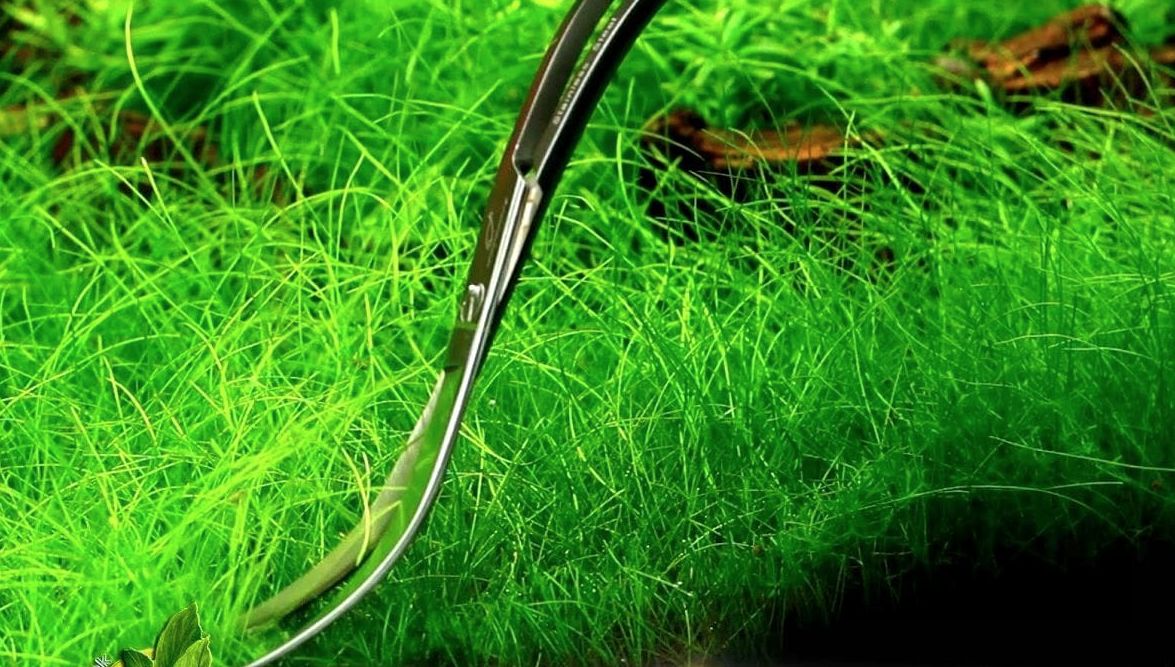
How to plant dwarf hairgrass
Here’s a step-by-step guide to successfully planting dwarf hairgrass:
1. Prepare the Substrate: Choose a fine-grained substrate, such as aquarium sand or a specialized planted tank substrate. Ensure a depth of at least 2-3 inches (5-8 cm) to give the roots enough space to anchor and spread.
2. Trim the Plants: Before planting, trim the dwarf hairgrass into smaller portions or individual clumps. This will make planting easier and allow for more even coverage across your desired carpet area.
3. Create Planting Holes: Use your fingers, tweezers, or a planting tool to create small holes in the substrate where you intend to place the plant. Space the holes evenly to allow room for the plants to grow and spread.
4. Planting Technique: Take a small portion of the trimmed dwarf hairgrass and gently insert it into the planting hole. Make sure the blades are just above the substrate surface. Press the substrate around the base of the plant to secure it in place.
5. Repeat and Cover: Continue the planting process, filling in the desired carpet area with the dwarf hairgrass. Aim for even spacing to achieve a uniform and dense carpet effect, ensuring there are no bare spots.
6. Initial Care: After planting, fill the aquarium with water slowly and gently to avoid disturbing the substrate. This helps ensure that your newly planted dwarf hairgrass remains undisturbed and properly submerged.